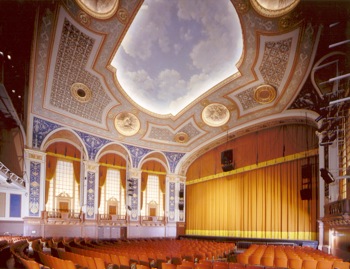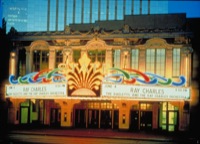
The next time your group visits a grand theater for a show, make the experience about more than just song and dance. Schedule a tour and discover stories that just may be as interesting as the entertainment listed on the marquee.
“The buildings are a show in themselves,” said Richard Sklenar, executive director for the Theatre Historical Society of America. “Back in the 1920s, many of these theaters were built as presentation theaters, offering silent movies and stage shows accompanied by an orchestra or a pipe organ.
“What was true back in the old days is true today: If the show is bad, you can be entertained by just looking at the walls.”
Playhouse Square
Cleveland
Playhouse Square boasts the largest theater restoration project in the world, according to Jeanie Emser, marketing and public relations manager.
“We have five theaters that were built in the early 1920s that have been saved — the wrecking balls were literally on site to destroy them. Today, they are once again grand palaces,” she said.
The five theaters, whose architectural styles include Roman, Italian Renaissance and French Imperial, are the State, the Ohio, the Hanna, the Allen and the Palace. Each was renovated and reopened starting in the early 1980s.
“Some of the highlights groups see on our theater tours are the largest lobby in the world at the State, where one of only four remaining murals by famous American artist James Daugherty remains, and three original chandeliers at the Palace,” Emser said.
“The Palace also has a giant blue urn from France whose twin is in the Louvre. The tours also have stories about the famous people who performed here, like Bob Hope, Bing Crosby and Frank Sinatra.”
Famous names continue to perform at Playhouse Square in Shakespearean and Broadway productions, live concerts and educational series that include writers, speakers, politicians and other newsworthy people.
(216) 771-4444, ext. 3251
www.playhousesquare.org
Ford’s Theatre
Washington, D.C.
Ford’s Theatre was the setting on the fateful night of April 14, 1865, where during a scene of Our American Cousin, John Wilkes Booth shot Abraham Lincoln while the president sat in his box with his wife and two guests. After Lincoln’s murder, the building served many purposes but was not appreciated as a historical venue for more than a century.
 |
| Courtesy by Maxwell MacKenzie, courtesy Ford’s Theatre |
Today, under the National Park Service, it is not only a National Historic Site but also a working theater. In August 2007, the theater was closed for its first renovation and restoration since 1968.
“Our reconstructed stage, spacious new lobby and entrance certainly enhance this 655-seat venue that has four productions throughout the year: The Christmas Carol, a springtime musical and two other American experience plays,” said Lauren Beyea, publicist.
A museum in the building includes Booth’s derringer and diary and the clothing and boots Lincoln wore the evening he was shot.
During the History on Foot walking tour, led by costumed actors, Detective McDevitt re-examines clues from the assassination conspiracy.
(202) 638-2367
www.fords.org
Fox Theatre
Detroit
The Detroit Fox, considered Detroit’s crown jewel, is one of the five Fox theaters built in the late 1920s by film pioneer William Fox. It was the first movie theater in the world to be constructed with built-in equipment for sound films and is the second-largest theater in the country after Radio City Music Hall in New York City.
 |
| By Balthazar Korab, courtesy Olympia Entertrainment |
Today, the 5,000-seat Broadway venue also boasts legendary acts like Aretha Franklin and Jerry Seinfeld.
Fully restored in 1988, the building has an illuminated facade that can be seen for several blocks. The building’s extravagant architecture includes a six-story-high grand lobby and a 13-foot-diameter chandelier in the auditorium. The gold embellished decorations throughout the theater come from around the world.
Tours can include a meal package at the nearby sports bar, the Hockeytown Cafe, where group members can enjoy a screening of the short film Encore on Woodward during their visit. The film offers historical footage of the Fox Theatre and interviews from past performers.
(313) 471-6677
www.olympiaentertainment.com
Mabel Tainter Center for the Arts
Menomonie, Wisconsin
The intimate, 269-seat Mabel Tainter Center for the Arts was constructed in 1889 as a tribute to Mabel Tainter, a lover of the arts who died in 1886 at the age of 19. “At the time, she was diagnosed with cancer of the side. Today, we think that was appendicitis,” said Erik Simonsen, executive director.
The Mabel Tainter has received a couple of restorations, including one in 2007. “While the design is Moorish in style with curved surfaces and handcarved details, the interior contains hand-stenciled walls and ceilings, marble staircases and floors, leaded stained-glass windows, brass fixtures, four fireplaces and the original Steer and Turner tracker pipe organ that has 1,597 pipes,” said Simonsen.
The theater also contains the Reading Room and the Laura Ingalls Wilder Historic Highway Information site.
Bank groups can enjoy a variety of productions at the Mabel Tainter, including those from a local theater guild and performances that range from comedy to ballet to rock and bluegrass acts. Tours offer the history of the building, including architecture and personal stories from days gone by.
(715) 235-0001
www.mabeltainter.com
Smoot Theatre
Parkersburg, West Virginia
The Smoot, originally built as a vaudeville house in 1926, was purchased by Warner Brothers in 1939 and for the next 56 years was known as the most posh movie house in town.
 |
| Courtesy Parkersburg CVB |
“In 1989, the theater escaped demolition by just a few days,” said Felice Jorgeson, artistic director and head volunteer since then.
The 720-seat theater has a classic, art-deco interior and includes four original chandeliers made of stained glass, crystal and cloisonné. “The ceiling is orange, turquoise and yellow, and as strange as it sounds, it’s beautiful and matches those chandeliers,” said Jorgeson.
Original photographs of the theater are on display. “Our philosophy is to restore and not renovate, and those photos have been very helpful,” Jorgeson said.
Live production series for children, adults and families are on the playbills and have included top-name entertainers such as Ed Asner, who recently starred as Franklin Delano Roosevelt in a one-man show.
Don’t miss this theater’s Dessert Tour, when Jorgeson gives the scoop on the Smoot, shows slides of the “before and after” and hosts coffee and sweets on the stage. She added, “This grand finale also includes live entertainment — it’s a real cabaret setting.”
(304) 422-7529
www.smoot-theatre.com
The Hennepin Theatre District
Minneapolis
For a diverse offering of entertainment, bank groups can choose from three restored theaters in downtown Minneapolis’ Hennepin Theatre District: the Pantages, the State and the Orpheum.
 |
| Courtesy Hennepin Theatre Trust |
All were built in the early 20th century for live performances. After hosting classic movies in the 1970s and 1980s, the theaters were closed and reopened in grand fashion less than 20 years ago.
Today, the State features six original chandeliers and a variety of murals, and hosts live Broadway touring productions and concerts.
Unexpected architectural discoveries were made during the renovation of the Orpheum, the largest of the three theaters, among them six friezes that were hidden under velour curtains and fake windows. The 2,000-pound chandelier in the main auditorium is the centerpiece for people attending elaborate Broadway productions.
The Pantages offers decorative plasterwork and a stained-glass skylight that was revealed after layers of paint were removed. Groups can enjoy intimate music, theater and dance productions at this beaux arts-style venue.
(612) 373-5665
www.hennepintheatretrust.org









